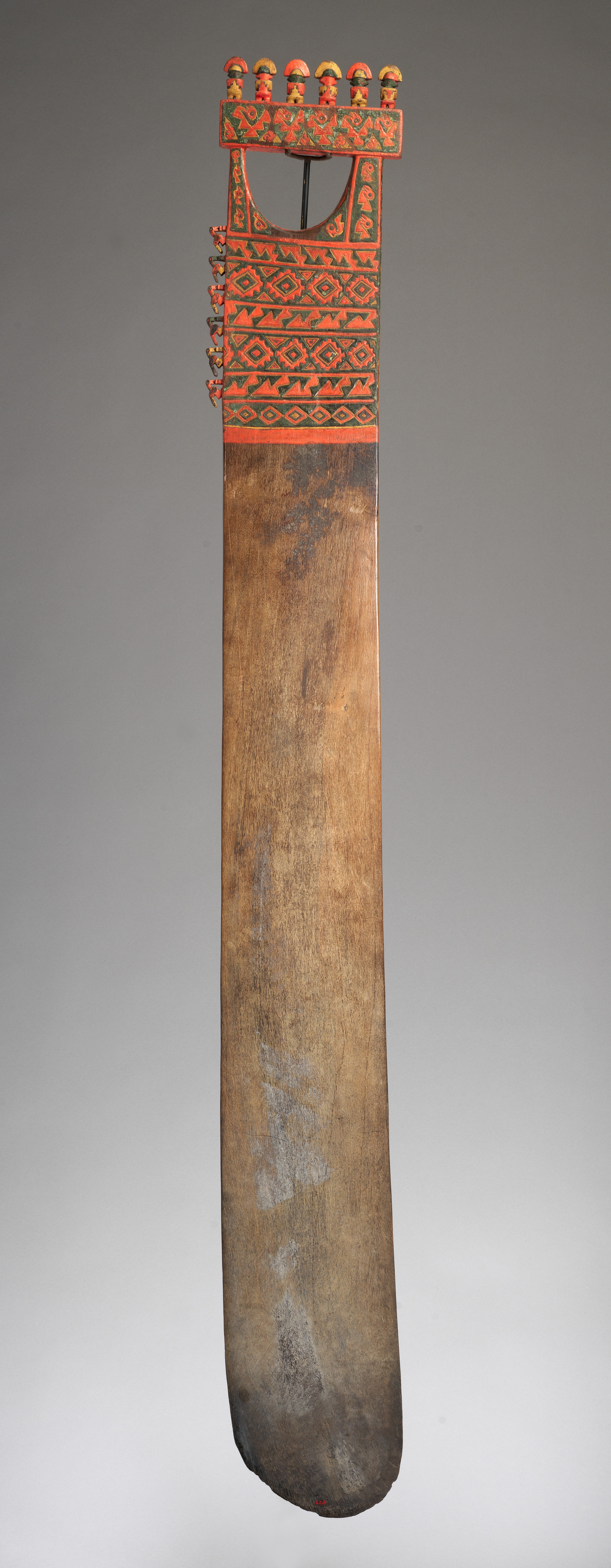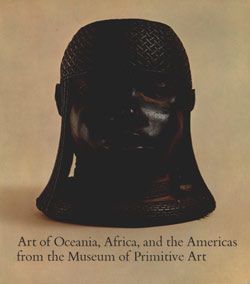Ceremonial digging stick
Not on view
This imposing ceremonial implement, made from algarrobo wood (Prosopis chilensis), features an unembellished lower section terminating in a paddle-like rounded end, and a carefully carved and painted upper section. Six three-dimensional figures holding beakers and wearing crescent headdresses surmount the top of the board, and six avian figures are carved on one side. Bands of avian and geometric designs are carved in low relief and painted with resin-based pigments of red, yellow and green. A semi-circular opening in this upper section may have served as a handle.
The figures along the top may represent men, as they wear short tunics. Other wood carvings of a similar form have rows of female figures, or men and women holding hands, as though they were dancing. The avian shapes usually represent sea birds, but fish, monkeys and foxes are depicted on other examples. Some of these wood implements have narrow rounded shafts with broad bottom sections (see, for example, other works in the Met’s collection, including accession number 1979.206.1026), and in one example the shaft has been carved to form an elegant openwork design (accession number 1979.206.1027). A few of these carvings were further embellished with gold or silver sheet. All of the scientifically excavated examples of these wood boards have been found in the Chincha and Ica valleys, on Peru’s south coast, and date to the 15th-16th century.
The function of these large wood boards has been a lively topic of discussion among scholars for many years. Sometimes called tomb markers, they have also been called remos (Spanish for paddle or oar) because of their resemblance to the rudder boards used on Precolumbian boats described by Spanish chroniclers (Koda, 1989; Kvietok, 1997). However, no evidence of blade deformation due to water immersion, as one might expect from nautical implements, has been observed. In contrast, analysis of use patterns of similar, but smaller, objects found in scientifically excavated tombs indicates that they are probably representations of agricultural implements used for preparing the soil for planting. Although this example and those of similar shape and size show no use patterns and would be awkward to handle, smaller wooden carvings with flat blades show abrasion patterns on the bottom ends consistent with having been thrust into soil containing small rocks. Tools with broad flat ends tapered at both the medial and axial edges would have been used to turn the soil similar to a plow, whereas other wooden objects with blunt or rounded ends would have served to break up the clods. Large, finely carved and painted boards such as the present example were likely ceremonial, used perhaps in rituals dedicated to agricultural fertility.
Further Reading
Koda, Yae. Prehistoric Agricultural Implements of the South Coast of Peru. PhD dissertation, University of California, Berkeley, 1989.
Kvietok, D. Peter. "Digging Sticks or Daggerboards? A Functional Analysis of Wooden Boards from the Ica Region," Andean Past: 1 (1987), pp. 247-274.
Published
Jones, Julie. Art of Empire: The Inca of Peru. New York: The Museum of Primitive Art, 1964, pp. 42-43, 46-48.
The Metropolitan Museum of Art. Art of Oceania, Africa, and the Americas from the Museum of Primitive Art. New York: The Metropolitan Museum of Art, 1969, no. 536.
Museum of Primitive Art. Masterpieces in the Museum of Primitive Art: Africa, Oceania, North America, Mexico, Central to South America, Peru. Handbook series. New York, NY: Museum of Primitive Art, 1965, no. 131.
Schmidt, Max. Kunst und Kultur von Peru. Berlin: Propylaen Verlag, 1929. pp. 428, 429, 431, 430, 432, 433.
Due to rights restrictions, this image cannot be enlarged, viewed at full screen, or downloaded.
This artwork is meant to be viewed from right to left. Scroll left to view more.





